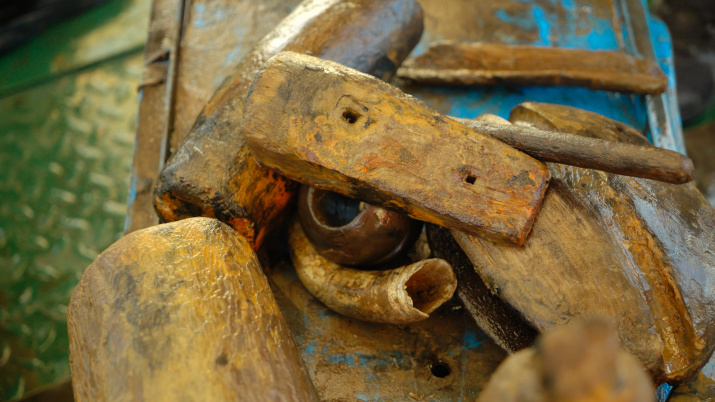In 2018, the Center for Underwater Research of the Russian Geographical Society carried out several expeditions, including the ongoing study of the German merchant ship called "The Archangel Raphael" sank in 1724 with a large cargo of smuggled goods. Underwater excavations have been going on for more than one year. Part of the cargo was raised from the depths of the sea: dishes, clothing, personal belongings of the crew, working and measuring tools. At the beginning of the new year, we talked with the archaeologist and restorer, diver-researcher of the RGS Center for Underwater Research Roman Prokhorov about the findings of the last season.
– Could you tell us, please, about the new findings raised from the trading ship "The Archangel Raphael."
Despite the short field season and bad weather, we continued the excavations of “The Archangel Raphael”. Among the interesting finds are: a barrel of grain, another sailor's broad-brimmed hat, a pair of woolen stockings and two boots. Various pieces of fabric were also found, one of which turned out to be the edge of a sailcloth or part of a sail. Clearing the stern of the vessel, between the planks, the divers found another navigator compass in good condition and weights for navigator charts.
Another three dozen of the stones were added to the stone tied with a rope, presented at the first exhibition of objects from "The Archangel Raphael", that the Finnish peasants probably used as a cargo when diving after the sunken goods. Speaking about the products there were found several fruits of turnip and three carcasses of eel, and one of the carcasses was gutted. Most likely, this is what the team ate.
– It is difficult to understand how these objects were preserved to nowday, because many of them were immersed in a layer of silt and where three centuries were reposed.
– Of course, most of the finds are preserved thanks to the tar, that has become a natural preserving agent, as well as thankds to the absence of sunlight and the special properties of the Baltic water. The hat, for example, was watered with the tar. It is noteworthy that even old things were very carefully repaired, patches were put on torn places.
Bible Plot
The fragments of the New Testament that had lain for 300 years under water became an absolutely unique find: they are 58 pages from different messages of the apostles. By happy coincidence, the sacred texts were not filled with tar, like most of the objects found on "The Archangel Raphael", moreover, they were not under mechanical wave action, and the effect of oxygen on paper slowed down in the mud.
I would like to note that the Center for Underwater Research of the RGS established its own conservation workshop, but in difficult cases, such as the restoration of the New Testament messages of the apostles, Center experts applied to the restorers of the All-Russian Art Scientific Restoration Center named after I.E.Grabar.
The excavation of the sunken ship continues not for the first year, many finds has already been raised, but nevertheless, more new objects are found on“The Archangel Rafael” in every new field season. What are the predictions for the future?
– Every year we wash out the new areas, although all in all there are not so many things left. All this time, archives are being studied, facts are being juxtaposed, thanks to which our expert Andrey Lukoshkov put forward the hypothesis that immediately after the flooding “The Archangel Raphael” laid at a depth of no more than 6 meters, and that allowed the Finnish peasants to get most of smuggled goods. For three centuries, the ship slipped to a depth of 13-15 meters.
– And how many seasons are you going to work on the excavations of "The Archangel Raphael"?
– It is difficult to say, but it is obvious that in a year or two we will finish exploring inner part of the vessel and move on to the outside, where the anchors and large objects lie. They will need to be conserved. But we will raise not all items. For example, the anchor windlass is now at the bottom - a device of the size of a large 6-meter log for lifting an anchor: here we are not ready to raise it, and the windlass is situated in a better conditions there. We have a lot of things that we do not lift, for example, fragments of barrels. The ultimate goal is to transfer these items to the museum, but the museum can not take everything. Most of the collection with "The Archangel Raphael" transferred to the Museum of the History of Kronstadt. By the way, the process of transferring items to this museum has not yet ended, beacause the excavations continue. Part of the ceramics found back in 2004 and a unique kaftan with trousers lifted from the bottom of the Gulf of Finland in 2014 are stored in the State Hermitage Museum.
Exhibition life
– The artifacts of the exhibition “Smuggling. Three Centuries Under Water” have been successfully exhibited for several years now. But how are exhibit items saved during the active exhibition life?
– I do not see any particular problems; underwater finds after a long conservation and restoration are more or less stable. Of course, it is about timing, but so far the observation of the exhibit items does not cause alarm. Over the past few years, exhibitions have been held at the State Hermitage Museum, the RGS Headquarters in St. Petersburg, at the Grand Menshikov Palace in Oranienbaum. Also all this time negotiations are conducted about an organization of the exhibition in Hamburg, where goods from Russia will finally arrive through 300 years.
Interviewed by Tatyana Nikolaeva
Photo: The Center for Underwater Research of the RGS







